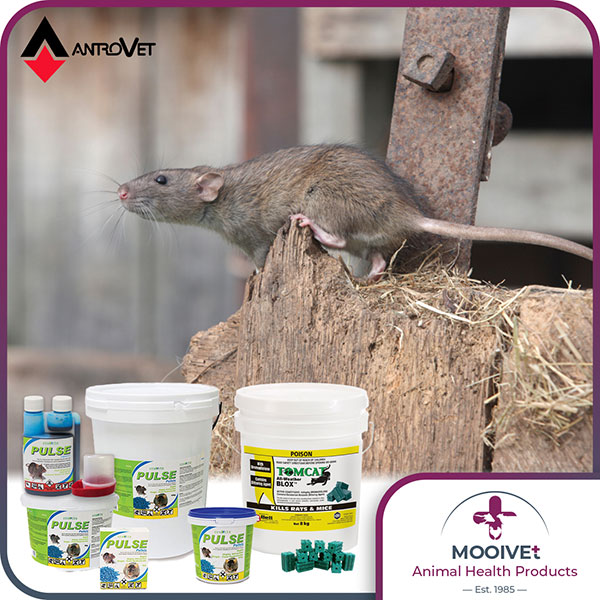Written by Cleary Martin, MSc (NWU: Integrated Pest Management and Environmental Sciences)
In South Africa a few species of rats and mice are of major concern for the agricultural industry, especially for intensive farming practices such as pig farming and poultry houses5, 11, as well as feed production mills. These rodents are known as the black rat/roof rat (Rattus rattus), brown rat/Norway rat (Rattus norvegicus), and the house mouse (Mus musculus).
Socioeconomic importance
Rats are economically important pests because not only do they threaten infrastructure, but the biosecurity on a farm as well, contributing to significant losses for farmers. Mice and rats can damage the buildings and demolish insulation of poultry and pig houses caused by their gnawing habit. Deterioration was detected of poultry houses in a span of five years due to rodents establishing burrows. This gives rise to a increase in energy costs, re-insulation costs as well as animals display poorer feed conversions.
The feed that rodents ingest and contaminate is a larger problem. Every rodent species will eat intensive farming feed, in doing so contaminating it with its droppings, urine and hair. As little as 100 rats can devour more than a ton of feed a year.
Rodents jeopardize the biosecurity on a farm and feed mills, as they are known to be carriers of different diseases like swine dysentery, toxoplasmosis, and salmonellosis, to name a few. The diseases are viruses and zoonotic pathogens, this means that they can jump from one species (rodent) to another (chicken/pig), increasing the risk of infected animals on your farm. Rats also damage eggs and kill chicks, causing great losses to poultry farmers.
Control methods/ Treatment
Considering the damage a rodent infestation can have on a farm, an effective integrated control program should be formulated. Rat infestation in an area is based on sightings of the rodents, trapping index, tracking, and the presence of live burrows.
One way of controlling rodents is by restricting shelter, food and water. To do this it is important to remove any vegetation, equipment and trash around the animal housing, this limits shelter/nesting areas for rodents and mice. It is critical to store feed appropriately since rodent infestations is popular in storage rooms. Predators like owls and cats can be used as a biological control agent, however this strategy cannot be used on its own, and should be part of an integrated control program. Elimination of all entry points (rodent proofing) is useful in long term maintenance of rodent free animal housing. When the physical control strategies, mentioned above, is unsuccessful a curative approach should be taken.
Trapping is economical, easy and an effective way to control rats. There are two different types of traps, they include non-poisonous sticky (glue) traps and mechanical traps6. The use of rodenticides is normally used for the control of rats because of its convenience and humane course of action. Both fast acting (acute) and slow acting (chronic) rodenticides are accessible.
To control Rodents on your farm, it is important to identify the specific species illustrated in Figure 1.
Mooivet offers several solutions to assist you with effective rodent control. Contact us today to discuss the solution that will best suit you.



Figure 1: Differences between Norway rat, Roof rat, and the House mouse.
⦁ Animal Kind, B.A. 2022. The difference between mice and rats | AnimalKind. https://animalkind.ca/difference-between-mice-and-rats/ Date of access: 06 Jun. 2022.
⦁ Bublitz, D.C., Wright, P.C., Bodager, J.R., Rasambainarivo, F.T., Bliska, J.B. & Gillespie, T.R. 2014. Epidemiology of Pathogenic Enterobacteria in Humans, Livestock, and Peridomestic Rodents in Rural Madagascar. PLOS ONE. 9(7):e101456.
⦁ Burgess, R. 2020. Rodent Control on Poultry Farms: Best Practices To Follow. Dalton Engineering. https://www.daltonengineering.co.uk/blogs/news/rodent-control-on-poultry-farms Date of access: 02 Jun. 2022.
⦁ Herbert, S., Hashemi, M., Chickering-Sears, C., Weis, S., Miller, K., … Zenk, Z. 2014. Rodent Control. Center for Agriculture, Food, and the Environment. https://ag.umass.edu/crops-dairy-livestock-equine/fact-sheets/rodent-control Date of access: 02 Jun. 2022.
⦁ Mitchell, A. 2015. Controlling Rodents on the Poultry Farm. https://www.thepoultrysite.com/articles/controlling-rodents-on-the-poultry-farm Date of access: 02 Jun. 2022.
⦁ Mohan Rao, A. 2015. Role of Rodents in Poultry Environs and their Management. Journal of Dairy, Veterinary & Animal Research. 2(4).
⦁ Paliy, A.P., Sumakova, N.V., Antonіuk, A.A., Behas, V.L. & Panasenko, A.S. 2021. Development and effectiveness of domestic bait in mouse-like rodents control. Ukrainian Journal of Ecology. 7.
⦁ Shivambu, N. 2020. Invasive rodents widely traded in the pet trade industry in Gauteng Province | Centre for Invasion Biology. https://blogs.sun.ac.za/cib/invasive-rodents-widely-traded-in-gauteng-province/ Date of access: 02 Jun. 2022.
⦁ Stenseth, N.C., Leirs, H., Skonhoft, A., Davis, S.A., Pech, R.P., … Wan, X. 2003. Mice, rats, and people: the bio-economics of agricultural rodent pests. Frontiers in Ecology and the Environment. 1(7):367–375.
⦁ Thornberry, F.D., Fowler, J.C., Cawley, W.O. & Parsons, V.V. 1975. RODENT CONTROL ON POULTRY FARMS. 4.
⦁ Vineetha, P.G., Mohan, R. & George, J. 2019. Rodent Control on Poultry Farms. https://thepoultrypunch.com/2019/12/rodent-control-on-poultry-farms/ Date of access: 02 Jun. 2022.

